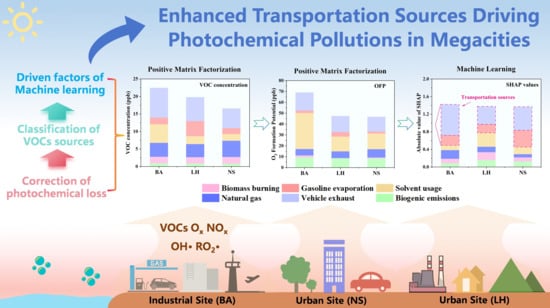Decoding the Primacy of Transportation Emissions of Formaldehyde Pollution in an Urban Atmosphere
Abstract
1. Introduction
2. Materials and Methods
2.1. Study Areas and Photochemical Age Correction
2.2. Positive Matrix Factorization Model
2.3. Machine Learning Model
3. Results
3.1. Overview of VOC Components and Activities
3.2. Analysis Characteristics of VOC Contribution Apportionment
3.3. Identification of the Critical Impact of Factors by Machine Learning
4. Conclusions
Supplementary Materials
Author Contributions
Funding
Institutional Review Board Statement
Informed Consent Statement
Data Availability Statement
Conflicts of Interest
References
- de Blas, M.; Ibáñez, P.; García, J.A.; Gómez, M.C.; Navazo, M.; Alonso, L.; Durana, N.; Iza, J.; Gangoiti, G.; de Cámara, E.S. Summertime high resolution variability of atmospheric formaldehyde and non-methane volatile organic compounds in a rural background area. Sci. Total Environ. 2019, 647, 862–877. [Google Scholar] [CrossRef] [PubMed]
- Qian, H.; Xu, B.; Xu, Z.; Zou, Q.; Zi, Q.; Zuo, H.; Zhang, F.; Wei, J.; Pei, X.; Zhou, W.; et al. Anthropogenic Oxygenated Volatile Organic Compounds Dominate Atmospheric Oxidation Capacity and Ozone Production via Secondary Formation of Formaldehyde in the Urban Atmosphere. ACS ES&T Air 2025, 2, 1033–1041. [Google Scholar] [CrossRef]
- Wang, C.; Huang, X.F.; Han, Y.; Zhu, B.; He, L.Y. Sources and Potential Photochemical Roles of Formaldehyde in an Urban Atmosphere in South China. J. Geophys. Res. Atmos. 2017, 122, 11–934. [Google Scholar] [CrossRef]
- Lowe, D.C.; Schmidt, U. Formaldehyde (HCHO) measurements in the nonurban atmosphere. J. Geophys. Res. Ocean. 2012, 88, 10844–10858. [Google Scholar] [CrossRef]
- Luecken, D.J.; Napelenok, S.L.; Strum, M.; Scheffe, R.; Phillips, S. Sensitivity of Ambient Atmospheric Formaldehyde and Ozone to Precursor Species and Source Types Across the United States. Environ. Sci. Technol. 2018, 52, 4668–4675. [Google Scholar] [CrossRef]
- Liu, T.; Lin, Y.; Chen, J.; Chen, G.; Yang, C.; Xu, L.; Li, M.; Fan, X.; Zhang, F.; Hong, Y. Pollution mechanisms and photochemical effects of atmospheric HCHO in a coastal city of southeast China. Sci. Total Environ. 2023, 859, 160210. [Google Scholar] [CrossRef]
- Yang, X.; Zhang, G.; Sun, Y.; Zhu, L.; Wei, X.; Li, Z.; Zhong, X. Explicit modeling of background HCHO formation in southern China. Atmos. Res. 2020, 240, 104941. [Google Scholar] [CrossRef]
- Ling, Z.H.; Zhao, J.; Fan, S.J.; Wang, X.M. Sources of formaldehyde and their contributions to photochemical O3 formation at an urban site in the Pearl River Delta, southern China. Chemosphere 2017, 168, 1293–1301. [Google Scholar] [CrossRef] [PubMed]
- Zhang, K.; Duan, Y.; Huo, J.; Huang, L.; Wang, Y.; Fu, Q.; Wang, Y.; Li, L. Formation mechanism of HCHO pollution in the suburban Yangtze River Delta region, China: A box model study and policy implementations. Atmos. Environ. 2021, 267, 118755. [Google Scholar] [CrossRef]
- Huang, X.-F.; Wang, C.; Zhu, B.; Lin, L.-L.; He, L.-Y. Exploration of sources of OVOCs in various atmospheres in southern China. Environ. Pollut. 2019, 249, 831–842. [Google Scholar] [CrossRef]
- Wei, C.-B.; Yu, G.-H.; Cao, L.-M.; Han, H.-X.; Xia, S.-Y.; Huang, X.-F. Tempo-spacial variation and source apportionment of atmospheric formaldehyde in the Pearl River Delta, China. Atmos. Environ. 2023, 312, 120016. [Google Scholar] [CrossRef]
- Zhu, B.; Han, Y.; Wang, C.; Huang, X.; Xia, S.; Niu, Y.; Yin, Z.; He, L. Understanding primary and secondary sources of ambient oxygenated volatile organic compounds in Shenzhen utilizing photochemical age-based parameterization method. J. Environ. Sci. 2019, 75, 105–114. [Google Scholar] [CrossRef]
- Gatlin, C.G. IARC Classifies Formaldehyde as Carcinogenic. Oncol. Times 2004, 26, 72. [Google Scholar]
- Zhang, H.; Zheng, Z.; Yu, T.; Liu, C.; Qian, H.; Li, J. Seasonal and diurnal patterns of outdoor formaldehyde and impacts on indoor environments and health. Environ. Res. 2022, 205, 112550. [Google Scholar] [CrossRef]
- Zhu, L.; Jacob, D.J.; Keutsch, F.N.; Mickley, L.J.; Scheffe, R.; Strum, M.; González Abad, G.; Chance, K.; Yang, K.; Rappenglück, B.; et al. Formaldehyde (HCHO) As a Hazardous Air Pollutant: Mapping Surface Air Concentrations from Satellite and Inferring Cancer Risks in the United States. Environ. Sci. Technol. 2017, 51, 5650–5657. [Google Scholar] [CrossRef] [PubMed]
- Bao, J.; Li, H.; Wu, Z.; Zhang, X.; Zhang, H.; Li, Y.; Qian, J.; Chen, J.; Deng, L. Atmospheric carbonyls in a heavy ozone pollution episode at a metropolis in Southwest China: Characteristics, health risk assessment, sources analysis. J. Environ. Sci. 2022, 113, 40–54. [Google Scholar] [CrossRef]
- Qian, X.; Shen, H.; Chen, Z. Characterizing summer and winter carbonyl compounds in Beijing atmosphere. Atmos. Environ. 2019, 214, 116845. [Google Scholar] [CrossRef]
- Cui, Y.; Hua, J.; He, Q.; Guo, L.; Wang, Y.; Wang, X. Comparison of three source apportionment methods based on observed and initial HCHO in Taiyuan, China. Sci. Total Environ. 2024, 926, 171828. [Google Scholar] [CrossRef]
- Tong, M.; Zhang, Y.; Zhang, H.; Chen, D.; Pei, C.; Guo, H.; Song, W.; Yang, X.; Wang, X. Contribution of Ship Emission to Volatile Organic Compounds Based on One-Year Monitoring at a Coastal Site in the Pearl River Delta Region. J. Geophys. Res. Atmos. 2024, 129, e2023JD039999. [Google Scholar] [CrossRef]
- Wang, Z.; Shi, Z.; Wang, F.; Liang, W.; Shi, G.; Wang, W.; Chen, D.; Liang, D.; Feng, Y.; Russell, A.G. Implications for ozone control by understanding the survivor bias in observed ozone-volatile organic compounds system. NPJ Clim. Atmos. Sci. 2022, 5, 39. [Google Scholar] [CrossRef]
- He, Z.; Wang, X.; Ling, Z.; Zhao, J.; Guo, H.; Shao, M.; Wang, Z. Contributions of different anthropogenic volatile organic compound sources to ozone formation at a receptor site in the Pearl River Delta region and its policy implications. Atmos. Chem. Phys. 2019, 19, 8801–8816. [Google Scholar] [CrossRef]
- Wu, Y.; Fan, X.; Liu, Y.; Zhang, J.; Wang, H.; Sun, L.; Fang, T.; Mao, H.; Hu, J.; Wu, L.; et al. Source apportionment of VOCs based on photochemical loss in summer at a suburban site in Beijing. Atmos. Environ. 2023, 293, 119459. [Google Scholar] [CrossRef]
- Zheng, H.; Kong, S.; Chen, N.; Niu, Z.; Zhang, Y.; Jiang, S.; Yan, Y.; Qi, S. Source apportionment of volatile organic compounds: Implications to reactivity, ozone formation, and secondary organic aerosol potential. Atmos. Res. 2021, 249, 105344. [Google Scholar] [CrossRef]
- Liu, X.; Lu, D.; Zhang, A.; Liu, Q.; Jiang, G. Data-Driven Machine Learning in Environmental Pollution: Gains and Problems. Environ. Sci. Technol. 2022, 56, 2124–2133. [Google Scholar] [CrossRef] [PubMed]
- Bi, K.; Xie, L.; Zhang, H.; Chen, X.; Gu, X.; Tian, Q. Accurate medium-range global weather forecasting with 3D neural networks. Nature 2023, 619, 533–538. [Google Scholar] [CrossRef] [PubMed]
- Lam, R.; Sanchez-Gonzalez, A.; Willson, M.; Wirnsberger, P.; Fortunato, M.; Alet, F.; Ravuri, S.; Ewalds, T.; Eaton-Rosen, Z.; Hu, W.; et al. Learning skillful medium-range global weather forecasting. Science 2023, 382, 1416–1421. [Google Scholar] [CrossRef]
- Chen, X.; Ma, W.; Zheng, F.; Wang, Z.; Hua, C.; Li, Y.; Wu, J.; Li, B.; Jiang, J.; Yan, C.; et al. Identifying Driving Factors of Atmospheric N2O5 with Machine Learning. Environ. Sci. Technol. 2024, 58, 11568–11577. [Google Scholar] [CrossRef] [PubMed]
- Ogata, S.; Takegami, M.; Ozaki, T.; Nakashima, T.; Onozuka, D.; Murata, S.; Nakaoku, Y.; Suzuki, K.; Hagihara, A.; Noguchi, T.; et al. Heatstroke predictions by machine learning, weather information, and an all-population registry for 12-hour heatstroke alerts. Nat. Commun. 2021, 12, 4575. [Google Scholar] [CrossRef]
- Chen, T.; Guestrin, C. XGBoost: A Scalable Tree Boosting System. In Proceedings of the 22nd ACM SIGKDD International Conference on Knowledge Discovery and Data Mining, San Francisco, CA, USA, 13–17 August 2016; pp. 785–794. [Google Scholar]
- Cheng, Y.; Huang, X.-F.; Peng, Y.; Tang, M.-X.; Zhu, B.; Xia, S.-Y.; He, L.-Y. A novel machine learning method for evaluating the impact of emission sources on ozone formation. Environ. Pollut. 2023, 316, 120685. [Google Scholar] [CrossRef]
- Lundberg, S.M.; Lee, S.-I. A unified approach to interpreting model predictions. In Proceedings of the 31st International Conference on Neural Information Processing Systems, Long Beach, CA, USA, 4–9 December 2017; pp. 4768–4777. [Google Scholar]
- Fang, H.; Huang, X.; Xiao, S.; Lowther, S.; Fu, X.; Zhang, Y.; Wu, T.; Hu, W.; Zhang, G.; Ding, X.; et al. Intermediate-Volatility Organic Compounds Observed in a Coastal Megacity: Importance of Non-Road Source Emissions. J. Geophys. Res. Atmos. 2022, 127, e2022JD037301. [Google Scholar] [CrossRef]
- McKeen, S.A.; Liu, S.C. Hydrocarbon ratios and photochemical history of air masses. Geophys. Res. Lett. 1993, 20, 2363–2366. [Google Scholar] [CrossRef]
- Stroud, C.A.; Roberts, J.M.; Goldan, P.D.; Kuster, W.C.; Murphy, P.C.; Williams, E.J.; Hereid, D.; Parrish, D.; Sueper, D.; Trainer, M.; et al. Isoprene and its oxidation products, methacrolein and methylvinyl ketone, at an urban forested site during the 1999 Southern Oxidants Study. J. Geophys. Res. Atmos. 2001, 106, 8035–8046. [Google Scholar] [CrossRef]
- Zheng, H.; Kong, S.; Yan, Y.; Chen, N.; Yao, L.; Liu, X.; Wu, F.; Cheng, Y.; Niu, Z.; Zheng, S.; et al. Compositions, sources and health risks of ambient volatile organic compounds (VOCs) at a petrochemical industrial park along the Yangtze River. Sci. Total Environ. 2020, 703, 135505. [Google Scholar] [CrossRef]
- Paatero, P.; Hopke, P.K.; Song, X.-H.; Ramadan, Z. Understanding and controlling rotations in factor analytic models. Chemom. Intell. Lab. Syst. 2002, 60, 253–264. [Google Scholar] [CrossRef]
- Paatero, P.; Tapper, U. Positive matrix factorization: A non-negative factor model with optimal utilization of error estimates of data values. Environmetrics 1994, 5, 111–126. [Google Scholar] [CrossRef]
- Shao, M.; Lu, S.; Liu, Y.; Xie, X.; Chang, C.; Huang, S.; Chen, Z. Volatile organic compounds measured in summer in Beijing and their role in ground-level ozone formation. J. Geophys. Res. Atmos. 2009, 114, D00G06. [Google Scholar] [CrossRef]
- Brown, S.G.; Eberly, S.; Paatero, P.; Norris, G.A. Methods for estimating uncertainty in PMF solutions: Examples with ambient air and water quality data and guidance on reporting PMF results. Sci. Total Environ. 2015, 518, 626–635. [Google Scholar] [CrossRef]
- Peng, X.; Huang, X.-F.; Wei, F.-H.; Yan, R.-H.; Tang, M.-X.; Ji, J.-P.; He, L.-Y. Identifying the key drivers in retrieving blue sky during rapid urbanization in Shenzhen, China. J. Clean. Prod. 2022, 356, 131829. [Google Scholar] [CrossRef]
- Carter, W.P.L. Development of the SAPRC-07 chemical mechanism. Atmos. Environ. 2010, 44, 5324–5335. [Google Scholar] [CrossRef]
- Carter, W.P.L. Development of Ozone Reactivity Scales for Volatile Organic Compounds. Air Waste 2012, 44, 881–899. [Google Scholar] [CrossRef]
- Snoek, J.; Larochelle, H.; Adams, R.P. Practical Bayesian optimization of machine learning algorithms. In Proceedings of the 26th International Conference on Neural Information Processing Systems, Lake Tahoe, NV, USA, 3–6 December 2012; Curran Associates Inc.: Red Hook, NY, USA, 2012; Volume 2, pp. 2951–2959. [Google Scholar]
- Liu, J.; Mauzerall, D.L.; Chen, Q.; Zhang, Q.; Song, Y.; Peng, W.; Klimont, Z.; Qiu, X.; Zhang, S.; Hu, M.; et al. Air pollutant emissions from Chinese households: A major and underappreciated ambient pollution source. Proc. Natl. Acad. Sci. USA 2016, 113, 7756–7761. [Google Scholar] [CrossRef]
- Zhu, B.; Cao, L.-M.; Xia, S.-Y.; Niu, Y.-B.; Man, H.-Y.; Du, K.; Yu, K.; Huang, X.-F. Identifying the airport as a key urban VOC source in the Pearl River Delta, China. Atmos. Environ. 2023, 301, 119721. [Google Scholar] [CrossRef]
- Sha, Q.; Zhu, M.; Huang, H.; Wang, Y.; Huang, Z.; Zhang, X.; Tang, M.; Lu, M.; Chen, C.; Shi, B.; et al. A newly integrated dataset of volatile organic compounds (VOCs) source profiles and implications for the future development of VOCs profiles in China. Sci. Total Environ. 2021, 793, 148348. [Google Scholar] [CrossRef] [PubMed]
- Gentner, D.R.; Worton, D.R.; Isaacman, G.; Davis, L.C.; Dallmann, T.R.; Wood, E.C.; Herndon, S.C.; Goldstein, A.H.; Harley, R.A. Chemical Composition of Gas-Phase Organic Carbon Emissions from Motor Vehicles and Implications for Ozone Production. Environ. Sci. Technol. 2013, 47, 11837–11848. [Google Scholar] [CrossRef]
- Shi, X.; Zheng, G.; Shao, Z.; Gao, D. Effect of source-classified and mixed collection from residential household waste bins on the emission characteristics of volatile organic compounds. Sci. Total Environ. 2020, 707, 135478. [Google Scholar] [CrossRef] [PubMed]
- Zheng, J.; Yu, Y.; Mo, Z.; Zhang, Z.; Wang, X.; Yin, S.; Peng, K.; Yang, Y.; Feng, X.; Cai, H. Industrial sector-based volatile organic compound (VOC) source profiles measured in manufacturing facilities in the Pearl River Delta, China. Sci. Total Environ. 2013, 456, 127–136. [Google Scholar] [CrossRef]
- Tsai, W.Y.; Chan, L.Y.; Blake, D.R.; Chu, K.W. Vehicular fuel composition and atmospheric emissions in South China: Hong Kong, Macau, Guangzhou, and Zhuhai. Atmos. Chem. Phys. 2006, 6, 3281–3288. [Google Scholar] [CrossRef]
- Zhao, Q.; Bi, J.; Liu, Q.; Ling, Z.; Shen, G.; Chen, F.; Qiao, Y.; Li, C.; Ma, Z. Sources of volatile organic compounds and policy implications for regional ozone pollution control in an urban location of Nanjing, East China. Atmos. Chem. Phys. 2020, 20, 3905–3919. [Google Scholar] [CrossRef]
- Brewer, J.F.; Millet, D.B.; Wells, K.C.; Payne, V.H.; Kulawik, S.; Vigouroux, C.; Cady-Pereira, K.E.; Pernak, R.; Zhou, M. Space-based observations of tropospheric ethane map emissions from fossil fuel extraction. Nat. Commun. 2024, 15, 7829. [Google Scholar] [CrossRef]
- Kanai, M. Photocatalytic upgrading of natural gas. Science 2018, 361, 647–648. [Google Scholar] [CrossRef] [PubMed]
- Liu, Y.; Song, M.; Liu, X.; Zhang, Y.; Hui, L.; Kong, L.; Zhang, Y.; Zhang, C.; Qu, Y.; An, J.; et al. Characterization and sources of volatile organic compounds (VOCs) and their related changes during ozone pollution days in 2016 in Beijing, China. Environ. Pollut. 2020, 257, 113599. [Google Scholar] [CrossRef]
- Cui, Y.; Liu, B.; Yang, Y.; Kang, S.; Wang, F.; Xu, M.; Wang, W.; Feng, Y.; Hopke, P.K. Primary and oxidative source analyses of consumed VOCs in the atmosphere. J. Hazard. Mater. 2024, 476, 134894. [Google Scholar] [CrossRef] [PubMed]
- Chan, L.Y.; Chu, K.W.; Zou, S.C.; Chan, C.Y.; Wang, X.M.; Barletta, B.; Blake, D.R.; Guo, H.; Tsai, W.Y. Characteristics of nonmethane hydrocarbons (NMHCs) in industrial, industrial-urban, and industrial-suburban atmospheres of the Pearl River Delta (PRD) region of south China. J. Geophys. Res. Atmos. 2006, 111, D11304. [Google Scholar] [CrossRef]
- Zhang, J.; Liu, Z.; Wu, Y.; Zhu, Y.; Cao, T.; Ling, D.; Wang, H.; Wang, S. The impacts of photochemical loss on the source apportionment of ambient volatile organic compounds: A case study in Northern China. Atmos. Environ. 2024, 333, 120671. [Google Scholar] [CrossRef]
- Hu, F.; Xie, P.; Tian, X.; Xu, J.; Li, A.; Lupaşcu, A.; Butler, T.; Hu, Z.; Lv, Y.; Zhang, Z.; et al. Integrated analysis of the transport process and source attribution of an extreme ozone pollution event in Hefei at different vertical heights: A case of study. Sci. Total Environ. 2024, 906, 167237. [Google Scholar] [CrossRef] [PubMed]
- Lyu, X.; Li, H.; Lee, S.-C.; Xiong, E.; Guo, H.; Wang, T.; de Gouw, J. Significant Biogenic Source of Oxygenated Volatile Organic Compounds and the Impacts on Photochemistry at a Regional Background Site in South China. Environ. Sci. Technol. 2024, 58, 20081–20090. [Google Scholar] [CrossRef]
- Kurtenbach, R.; Becker, K.H.; Gomes, J.A.G.; Kleffmann, J.; Lörzer, J.C.; Spittler, M.; Wiesen, P.; Ackermann, R.; Geyer, A.; Platt, U. Investigations of emissions and heterogeneous formation of HONO in a road traffic tunnel. Atmos. Environ. 2001, 35, 3385–3394. [Google Scholar] [CrossRef]
- Xia, S.-Y.; Wang, C.; Zhu, B.; Chen, X.; Feng, N.; Yu, G.-H.; Huang, X.-F. Long-term observations of oxygenated volatile organic compounds (OVOCs) in an urban atmosphere in southern China, 2014–2019. Environ. Pollut. 2021, 270, 116301. [Google Scholar] [CrossRef]
- Huang, X.-F.; Zhang, B.; Xia, S.-Y.; Han, Y.; Wang, C.; Yu, G.-H.; Feng, N. Sources of oxygenated volatile organic compounds (OVOCs) in urban atmospheres in North and South China. Environ. Pollut. 2020, 261, 114152. [Google Scholar] [CrossRef]
- Atkinson, R.; Arey, J. Atmospheric Degradation of Volatile Organic Compounds. Chem. Rev. 2003, 103, 4605–4638. [Google Scholar] [CrossRef]
- Atkinson, R.; Baulch, D.L.; Cox, R.A.; Crowley, J.N.; Hampson, R.F.; Hynes, R.G.; Jenkin, M.E.; Rossi, M.J.; Troe, J.; Subcommittee, I. Evaluated kinetic and photochemical data for atmospheric chemistry: Volume II – gas phase reactions of organic species. Atmos. Chem. Phys. 2006, 6, 3625–4055. [Google Scholar] [CrossRef]
- Parrish, D.D.; Stohl, A.; Forster, C.; Atlas, E.L.; Blake, D.R.; Goldan, P.D.; Kuster, W.C.; de Gouw, J.A. Effects of mixing on evolution of hydrocarbon ratios in the troposphere. J. Geophys. Res. Atmos. 2007, 112. [Google Scholar] [CrossRef]
- Wei, D.; Cao, C.; Karambelas, A.; Mak, J.; Reinmann, A.; Commane, R. High-Resolution Modeling of Summertime Biogenic Isoprene Emissions in New York City. Environ. Sci. Technol. 2024, 58, 13783–13794. [Google Scholar] [CrossRef] [PubMed]
- U.S. Environmental Protection Agency (EPA). EPA Positive Matrix Factorization (PMF) 5.0 Fundamentals and User Guide; EPA/600/R-14/108; Office of Research and Development, U.S. Environmental Protection Agency: Washington, DC, USA, 2014.
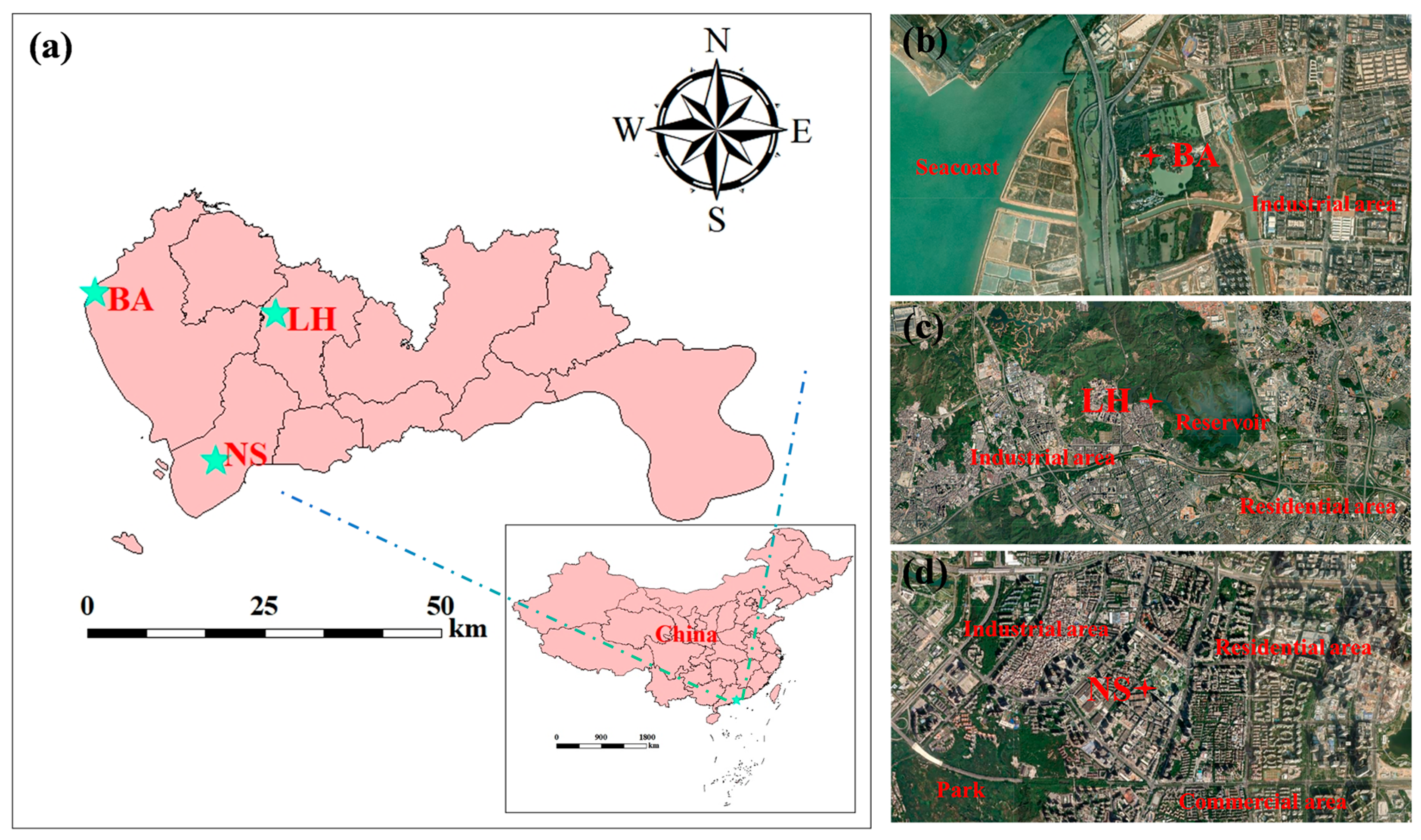
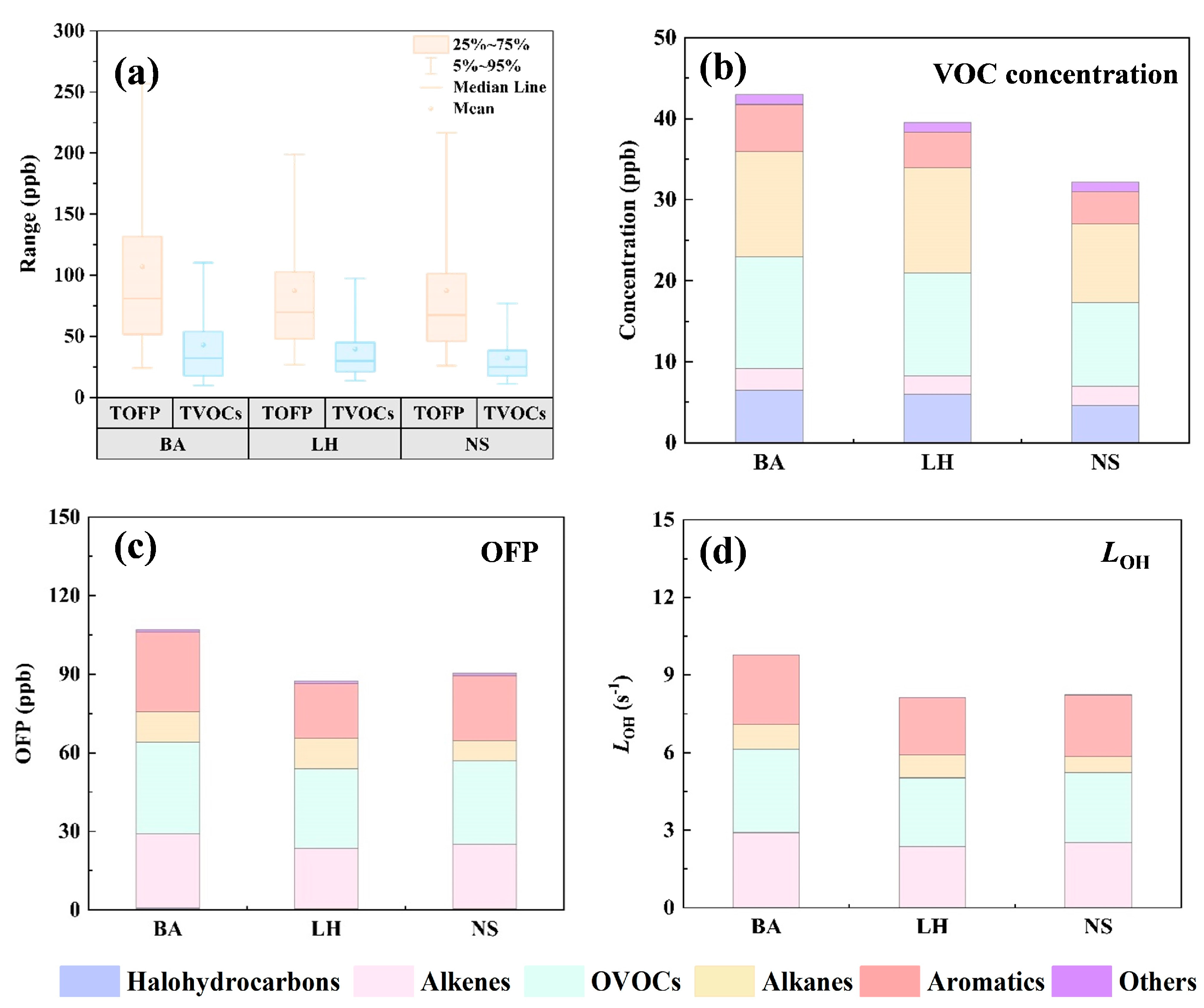
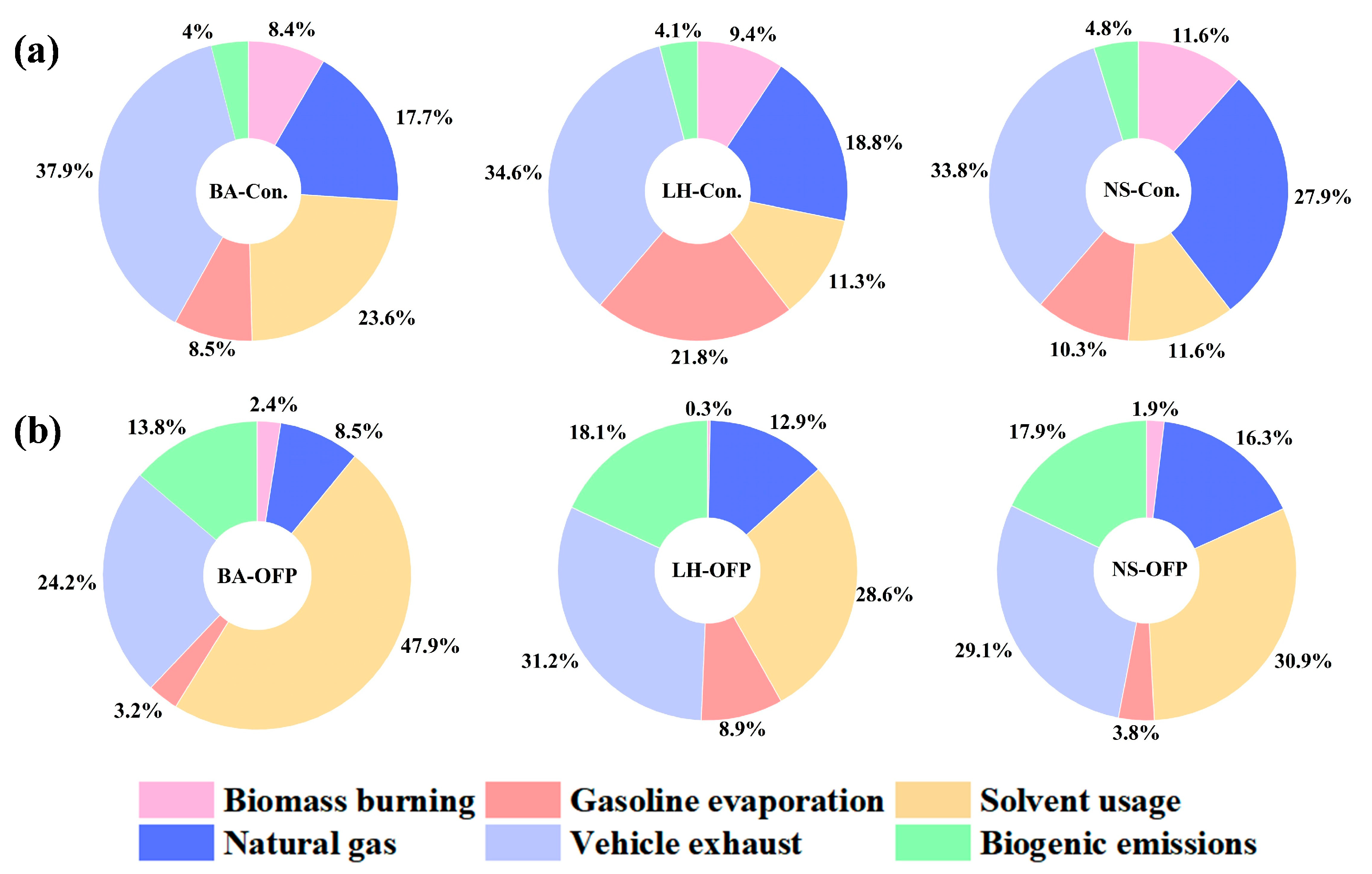
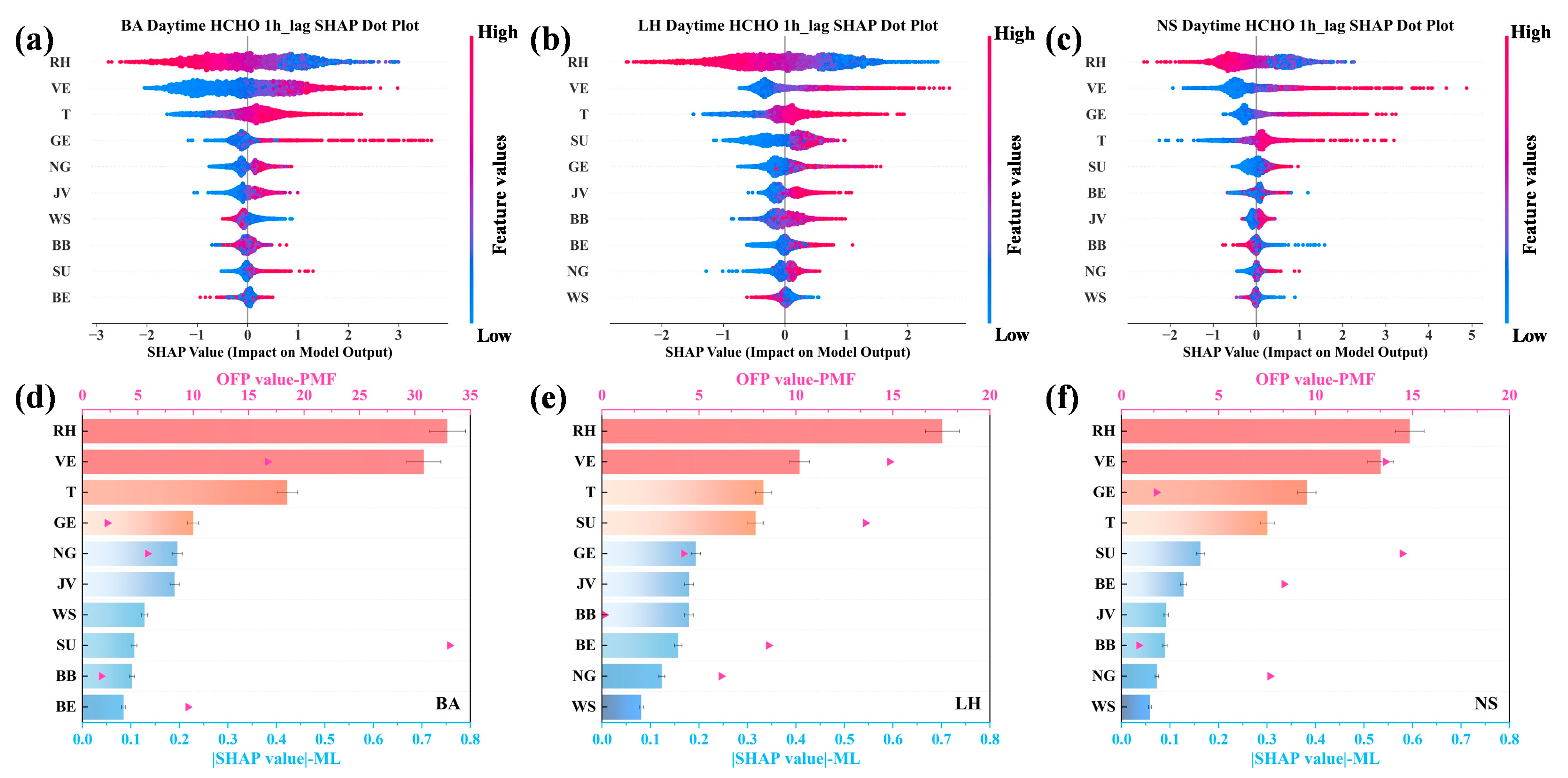

Disclaimer/Publisher’s Note: The statements, opinions and data contained in all publications are solely those of the individual author(s) and contributor(s) and not of MDPI and/or the editor(s). MDPI and/or the editor(s) disclaim responsibility for any injury to people or property resulting from any ideas, methods, instructions or products referred to in the content. |
© 2025 by the authors. Licensee MDPI, Basel, Switzerland. This article is an open access article distributed under the terms and conditions of the Creative Commons Attribution (CC BY) license (https://creativecommons.org/licenses/by/4.0/).
Share and Cite
Liu, S.-Q.; Ma, H.-N.; Tang, M.-X.; Shao, Y.-M.; Yao, T.-T.; He, L.-Y.; Huang, X.-F. Decoding the Primacy of Transportation Emissions of Formaldehyde Pollution in an Urban Atmosphere. Toxics 2025, 13, 643. https://doi.org/10.3390/toxics13080643
Liu S-Q, Ma H-N, Tang M-X, Shao Y-M, Yao T-T, He L-Y, Huang X-F. Decoding the Primacy of Transportation Emissions of Formaldehyde Pollution in an Urban Atmosphere. Toxics. 2025; 13(8):643. https://doi.org/10.3390/toxics13080643
Chicago/Turabian StyleLiu, Shi-Qi, Hao-Nan Ma, Meng-Xue Tang, Yu-Ming Shao, Ting-Ting Yao, Ling-Yan He, and Xiao-Feng Huang. 2025. "Decoding the Primacy of Transportation Emissions of Formaldehyde Pollution in an Urban Atmosphere" Toxics 13, no. 8: 643. https://doi.org/10.3390/toxics13080643
APA StyleLiu, S.-Q., Ma, H.-N., Tang, M.-X., Shao, Y.-M., Yao, T.-T., He, L.-Y., & Huang, X.-F. (2025). Decoding the Primacy of Transportation Emissions of Formaldehyde Pollution in an Urban Atmosphere. Toxics, 13(8), 643. https://doi.org/10.3390/toxics13080643




